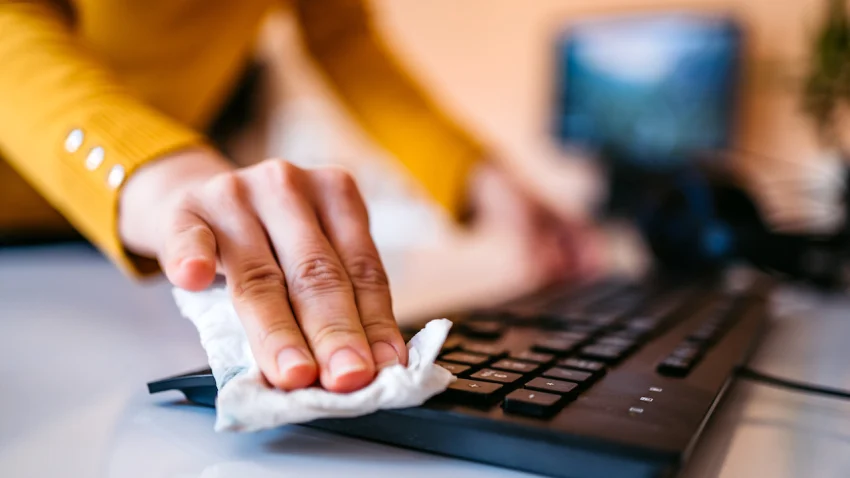Cleaning your computer keyboard is important for maintaining hygiene and functionality. Here’s a general guide on how to clean it:
- Turn off your computer: Shut down your computer and unplug the keyboard from the USB port to prevent any electrical issues or accidental typing.
- Shake out debris: Turn the keyboard upside down and gently shake it to dislodge any loose debris, crumbs, or dust.
- Use compressed air: Use a can of compressed air to blow out debris from between the keys. Hold the keyboard at an angle to help dislodge stubborn particles.
- Clean with a soft brush: Use a soft, clean brush (like a small paintbrush or a clean makeup brush) to sweep away dust and particles from the surface and between the keys.
- Disinfecting wipes: Dampen a lint-free cloth or disinfecting wipe with a small amount of isopropyl alcohol (70% or higher). Gently wipe the surfaces of the keys and the keyboard frame. Avoid getting moisture into the keyboard switches.
- Clean the keycaps: If your keyboard allows, gently remove the keycaps using a keycap puller or carefully with your fingers. Clean them individually with a cloth dampened with isopropyl alcohol.
- Dry thoroughly: After cleaning, allow the keyboard to air dry completely before plugging it back in and using it.
- Regular maintenance: To keep your keyboard clean, regularly wipe it down with a slightly damp cloth and avoid eating or drinking over it.
Following these steps will help keep your keyboard clean and functioning well.
Keyboards are our entry into the digital world. They allow us to chat, search, play, learn, and control. So why do we treat them as if they’re just another kitschy accessory on a cluttered desk?
Dirt, dust, and food crumbs can make for a messy (if not unhygienic) peripheral, which, if left untended long enough, will ultimately disrupt your device’s—and your own—functionality. For those who prefer a built-in keypad, check out our tips on how to clean your laptop. Otherwise, gather your cleaning supplies and read on to learn how to spruce up a wireless or USB keyboard.
The most obvious solution is also the easiest: Turn the entire keyboard upside down, give it a few good shakes, and see what you uncover. You may want to unplug the device or turn off its wireless function first. And we advise you to lay down a paper towel or napkin to catch any debris. Once your safe zone is established, flip the accessory so the keys are facing down and tap.
Try holding the board at different angles, patting it firmly but gently across the entire surface to knock free any loose particles. Expect a cascade of pastry remnants, eyelashes, trail mix, dead skin cells, and whatever else has crept between your keys since their last cleaning. If you’re using a keyboard with removable keycaps (a mechanical keyboard, for instance), carefully pull those off and give the panel another upside-down shake.
Don’t forget to give your desk a post-tip clean (ideally with an antibacterial spray). Not only will it mop up whatever’s left of your keyboard crud, but it’ll eliminate whatever germs are hanging out.
Still disgusted by your device? It may be time to invest in a keyboard brush, which come in all shapes and sizes to help sweep out the crud hiding below that QWERTY layout. Take your pick of mini brooms, available in different colors, material, or as part of a multi-function toolkit.
Not everyone wants to get so handsy with their polluted keyboard, which is where the next option comes in. Air Duster—aka “canned air,” aka “compressed air,” aka “dusting gas”—is used to dislodge dust and dirt with a pressurized blast. Before inserting the straw-like plastic hose and blasting, though, you’ll want to take some basic precautions.
